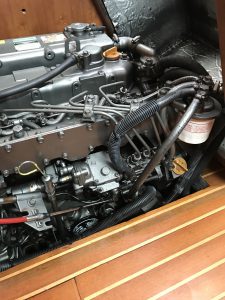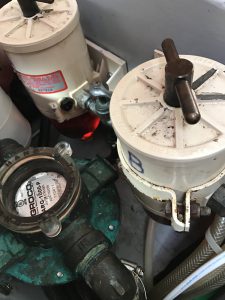Diesel Mechanics and Other Fun Stuff
Good Karma’s Diesel Engine
We finally got to work last week to do maintenance on our diesel engine. Every 150 to 300 hours of running time you need to change the engine oil, which is called lube oil to distinguish it from fuel oil, which is what diesel fuel is called. Also, need to change the oil filter and the fuel filters.
Step one: Acquire the necessary tools if you don’t have them. One unique item was a pump to pump out the oil from the engine. Can’t just go underneath and open the oil drain plug as you would in a car because the engine is basically below sea level. Also need absorbent mats, rubber gloves and a bunch of trash bags.
Step two: Get the new filters and oil. Had to make several special trips to find everything for our particular system.
Step three: Go to work. It took both of us about 4 or 5 hours to complete, mainly because this was the first time we tried it but also because it’s a bit of work. Here are the steps:
A) Change the Racor filters and clean the bulbs. The photo at the bottom shows these filters. They are pre-filters for the engine and the bulbs tend to fill with gunk that may be in the diesel, they also trap water. In the photo below, you can see the red glow of the bulbs located at the bottom of the beige cylinders. Supposedly you can drain these bulbs via a valve located at the bottom, but we only had about an inch of clearance and nothing to catch the drained fuel in. So we pumped the fuel out to clean them. Replaced the 2 micron filters.
B) Change the engine fuel filter. This is the secondary filter on the engine and normally does not need to be replaced often or at all if you have the pre-filters as we do. But since I have no idea when it was last changed, I decided to do it anyway. In the top pic the filter is the white can located on the mid-left border of the photo. Unscrew this and catch the fuel that spills, which was easier for this filter as we had a lot more room. Replace the filter and bleed the air from the fuel lines. This involves loosening a bolt and pressing the lifting pump until you re-fill the filter and no air comes out as you pump, then tightening the bolt. Do this again for the injection pump and the individual cylinder lines. Can’t have any air bubbles in the fuel line or the engine will stall.
C) Get the engine started and run it for 5 minutes to warm up the lube oil. Turn the engine off, pull out the dipstick and pump the oil out with your new oil pump device. When done, pump out the oil from what is called the marine gear. This is what the engine turns to drive the propeller.
D) Replace the oil filter, the black can way low down in the center of the photo. This was quite difficult due to the tight space, the USUAL case on a sailboat. Spilled a bunch of oil into the bilge, not sure how to really prevent that. Replace oil filter and add new engine and marine gear oil. Run the engine for about 10 minutes to ensure there is no air in the system and there are no leaks.
Also last week we had Mike from Hartge Yacht (in Maryland of all places) re-install the VHF, add GPS to the radio and run the cable to the cockpit for the remote speaker-microphone. He gave us a lot of info about how our electrical system works, how much charging we should do, and pointed out our battery monitor wasn’t really working. It was basically a loose wire. Got that fixed and are now charging/discharging the batteries correctly.
Next: Goodbye Vero!
Racor Fuel Filters
Posted in Sailing by Mark with comments disabled.

